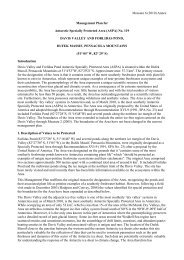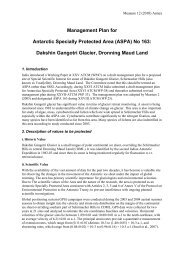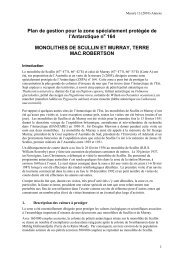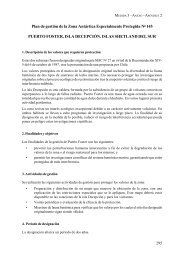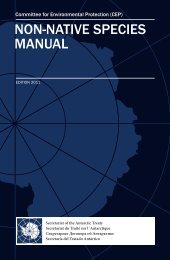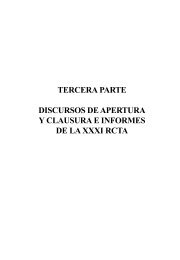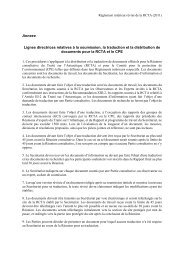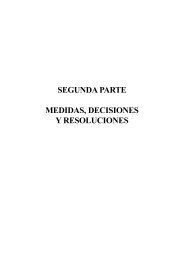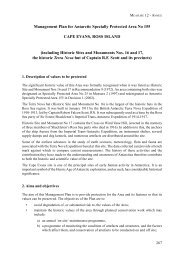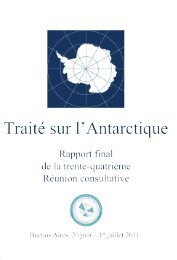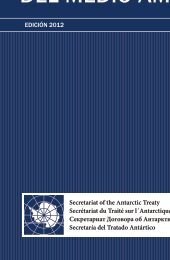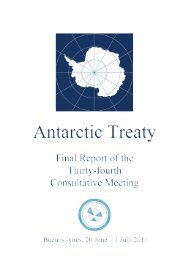Scott Base and McMurdo Station - Antarctic Treaty Secretariat
Scott Base and McMurdo Station - Antarctic Treaty Secretariat
Scott Base and McMurdo Station - Antarctic Treaty Secretariat
Create successful ePaper yourself
Turn your PDF publications into a flip-book with our unique Google optimized e-Paper software.
Raytheon Polar Services Company employs a dedicated team of waste h<strong>and</strong>lers experienced in the range of wastemanagement issues. Six employees remain on station during winter to h<strong>and</strong>le waste management. A weekly <strong>and</strong>annual waste management report is prepared by Raytheon.There is little surface litter present at <strong>McMurdo</strong> <strong>Station</strong>. Large areas of the station precinct are used to storeequipment <strong>and</strong> materials. Some of the items are obviously stored for use in the immediate future, such ascomponents of South Pole station which is being rebuilt. Other materials appeared to be have been there forsome years <strong>and</strong> it was not immediately obvious whether any of the items could be regarded as surplus <strong>and</strong> couldbe removed. We were advised that considerable efforts have been made to remove redundant materials <strong>and</strong> tomake an inventory of remaining items.Waste disposal by removal from the <strong>Antarctic</strong> <strong>Treaty</strong> Area (Article 2)The following materials are removed from <strong>McMurdo</strong> <strong>Station</strong> in accordance with Annex III of the Protocol: radioactivematerials; electrical batteries (segregated into types); fuels <strong>and</strong> lubricants, plastics (also segregated); off-cutsof chemically treated timber; fuel drums no longer required; <strong>and</strong> other solid wastes which are sorted beforereturn. Organic wastes such as food <strong>and</strong> food contaminated wastes are returned frozen to the United States fordisposal. Hazardous wastes <strong>and</strong> wastes containing heavy metals, acutely toxic or harmful persistent compoundsare sorted, stored <strong>and</strong> packed separately for return to the United States for recycling or disposal. A large grinderis used to shred untreated timbers <strong>and</strong> surplus pallets before being baled for return to the United States.Cardboard cartons are flattened <strong>and</strong> baled for recycling.Some wastes are recycled for use at <strong>McMurdo</strong>. This includes waste lubricants that are used to feed the boiler thatheats the waste management facility. A large volume of surplus clothes, boots, domestic appliances <strong>and</strong> householdgoods are made available to other station personnel through an exchange facility called “Skua Central”. Thehazardous waste building has a drum washer to clean fuel drums to enable them to be reused on station ratherthan take up valuable shipping space.Apart from the waste management building, there is a large fenced compound for the sorting, packing <strong>and</strong>storage of wastes. Other areas around the station are used for bulk storage of packed wastes, such as strappedtriwall containers of frozen food wastes awaiting removal by ship.The Australian observer team was impressed by the degree of segregation achieved at <strong>McMurdo</strong> <strong>Station</strong> <strong>and</strong> theamount of effort put into recycling of waste. We were advised that because of the volumes produced <strong>and</strong> thediscipline achieved in segregation, this is cost-effective because of the financial return for recyclable wastes. Upto 65% of returned waste is recycled.Waste disposal by incineration (Article 3)There is no evidence of open burning being conducted at <strong>McMurdo</strong> <strong>Station</strong>. No waste is destroyed byincineration. The station has a unit capable of burning oils from contaminiated soils. However this unit has neverbeen commissioned pending evaluation of its efficiency, effectiveness <strong>and</strong> the environmental impacts of operatingthe unit itself.Other waste disposal on l<strong>and</strong> (Article 4)There was no evidence of waste disposal on l<strong>and</strong> or into freshwater systems at Ross Isl<strong>and</strong>.Disposal of waste in the sea (Article 5)Sewage <strong>and</strong> domestic liquid wastes are discharged through a waste water treatment plant commissioned in 2003.The system consists of three parallel “trains”, two of which are required to treat the liquid waste of the station atits maximum capacity of 1,100 people. The operation of three trains enables optimum operation of the systemto produce clean effluent into the sea. As noted above, there is detailed monitoring of the operation of the systemto ensure a clean product. The sewage outfall is directly into the sea adjacent to the station <strong>and</strong> within a fewhundred metres of the seawater intake for the reverse osmosis water production system. The system treatsapproximately 35 millions litres per year, <strong>and</strong> produces about 30 tonnes of compressed dried solids that arereturned to the United States for incineration.Storage of waste (Article 6)All wastes to be removed from the <strong>Antarctic</strong> <strong>Treaty</strong> area are stored at the waste h<strong>and</strong>ling facility, mostly externally,in sealed <strong>and</strong> labelled containers awaiting shipping.



